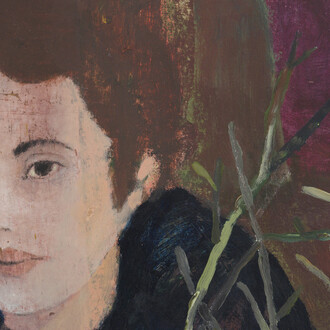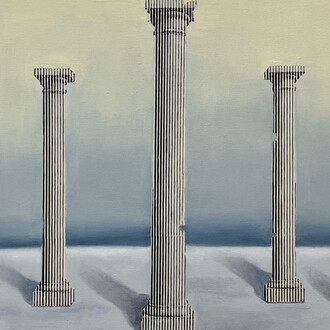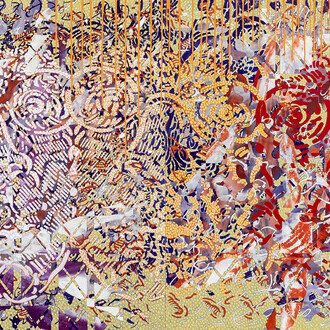White Cube Paris is pleased to present a solo exhibition of work spanning the early 1960s to mid-1980s by the late Italian artist Salvatore Emblema (1929–2006). Informed by his rural surroundings in southern Italy, Emblema worked with natural materials and organic matter, including raw jute, leaves, volcanic earth, petrified lava and oxidised metals. Working independent of the country’s post-war avant-garde, which was centred in the northern cities, Emblema’s artistic life was committed to a set of concerns that rendered his work resistant to stylistic classification yet indebted to the movements of his time.
Bringing together 15 of Emblema’s paintings and one sculpture, the exhibition charts the development of his approach during a formative period of his career, and across which an array of influences are palpable. The artist’s engagement with the interplay between space, colour, texture and light – and the creation of compositions relying on pure pigment and abstract, minimalist forms – foreground his focus on the notion of transparency in painting, which would go on to become a lifelong subject of enquiry. This fascination with transparency is best reflected in his preference for sackcloth and raw jute as painting supports. Considering the materials’ open-weave structure, the artist emphasises the journey of light as it penetrates the surface, light being a guiding principle above all else. ‘I was born on the 25th of April 1929. To be exact, I saw the light of day. And once I saw that light, I could never leave it. I belong to light’, the artist has stated.
Emblema was born in Terzigno, Naples, which sits at the foot of Mount Vesuvius and overlooks the archaeological site of Pompeii. In 1944 he witnessed the last major eruption of the volcano, which smothered his hometown in layers of ash. This experience had a profound impact on the artist, instilling in him an awareness of how landscape, identity and geological conditions inform each other. In the late 1940s, Emblema decided to withdraw from his studies at Accademia di Belle Arti di Napoli, choosing instead to travel to Rome, where he first began working with dried leaves and jute sacks. Though this was a decision initially driven by financial limitations, the artist attested: ‘my main concern was to have a direct relationship with truth, with what I felt was truth. Leaves and sackcloth were truth to me’. It was during this period that Emblema also met Jean Dubuffet, whose unorthodox approach – including mixing oil paint with mud, sand, glass, gravel and cement – further encouraged his interest in working with materials widely considered debased, in pursuit of the natural, textural and earthly.
In 1957, Emblema was invited to New York by David Rockefeller, who was a significant supporter of his practice. There, he encountered the Abstract Expressionists, including Mark Rothko and Barnett Newman, whose studios he frequented. It was also in New York, ironically, that Emblema discovered the vibrancy of Roman frescoes and the ancient secrets of Pompeii on his visits to the Metropolitan Museum of Art. Although he was drawn to elements of American Modernism – in particular, Rothko’s exploration of the metaphysical qualities of colour – what Emblema primarily took away from his time in the United States was a renewed appreciation of his own Pompeiian heritage. When he returned to Terzigno the following year, he embraced this in earnest, utilising ancient techniques such as mixing earth with organic transparent glues to create raw pigment. The earliest works in the exhibition, Untitled / self-portrait (1963) and Untitled (1963), demonstrate the artist’s experimentations with application, which ranges from a thick diffusion of colour across the jute to fine, attenuated, scratches in the surface.
In the mid-1960s, Emblema befriended the art historian and critic Giulio Carlo Argan, who became one of his most ardent supporters, and whose trusted advice propelled the artist’s development and application of the ideas of transparency. Encouraged by Argan – who remarked that the canvas was already the colour – Emblema began to gradually reduce his use of pigment on the surface. In Untitled (1969), for example, a thick black rectangle is applied to the jute canvas following its edges; the remainder left raw and uncoloured. By the late 1960s, the artist had begun to remove threads of jute to further open the support and allow more light to enter the painting. In experimenting with dying the jute, Emblema is seen, in Untitled (1972) and Untitled (1974), to eschew the external application of paint altogether. These works take on a screen-like quality and are indicative of Emblema’s desire to enliven the dead ‘space behind the canvas’ – a challenge posed by Argan. This dismantling gesture recalls Argentine-Italian artist Lucio Fontana’s ‘Cuts’ (1958–68), a series of flat monochrome paintings whose smooth surface is interrupted by violent slashes, as its title describes. Although Emblema considered Fontana’s approach to be an ‘intelligent gesture’, he believed that the problem of the space behind the canvas remained unresolved.
Shown alongside Emblema’s canvases are two three-dimensional works that set out to eradicate this problem in its entirety. In Untitled / bandiera (1975), the materiality of the painting is transformed into a freestanding, three-dimensional object that can be fully circumnavigated by the viewer. There can be no dead space behind a painting when no such space exists, but rather, is replaced by an all-encompassing, perpetual engagement between object and environment. The latest work on display, Study for a tree and a column (1992) further interrogates the boundaries between painting and sculpture. In it, green pigment has been applied to two ‘capitals’ of carved wood, one of which is placed atop a corrugated ‘trunk’ of the same material. The density of material would initially seem to diverge from Emblema’s dedication to transparency, but these objects speak to his belief that organic matter itself contains light, which in turn echoes his statement about his own birth.
Emblema’s oeuvre carries with it suggestions of various post-war movements, including Arte Povera, Process Art, Minimalism and Land Art. However, perhaps as a result of the specificity of his artistic concerns and his strong attachment to his locality, he managed to avoid reduction to these classifications. Argan introduced Emblema to various artists of the time, including Alberto Burri, who had been working with burlap sacks since the early 1950s. Burri’s turn to this material had a political impetus as, following the Second World War, the United States sent such sacks filled with food to a destitute Europe. By contrast, Emblema’s interest in jute lay in its material reality as its very own form of ‘truth’. Even if the artist’s emphasis on materiality and light gestures towards the concept of dematerialisation at the heart of Arte Povera, his personal predilection for painting set him apart from his contemporaries. Exposed though he was to a wide range of influences, Emblema was steadfast in his dedication to certain interrogations – ones that would result in an artistic language that returns to the landscape and history of his immediate surroundings, while at the same time taking him far beyond it.
















